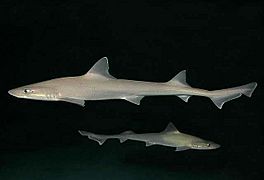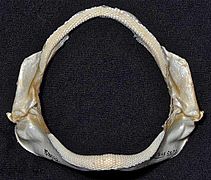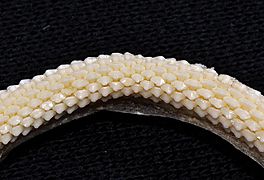Dusky smooth-hound facts for kids
Quick facts for kids Dusky smooth-hound |
|
|---|---|
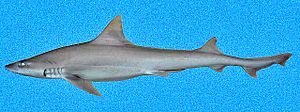 |
|
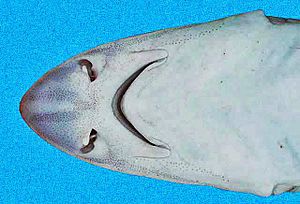 |
|
| Conservation status | |
| Scientific classification | |
| Genus: |
Mustelus
|
| Species: |
canis
|
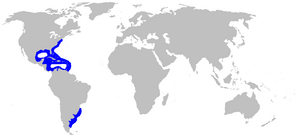 |
|
| Range of the dusky smooth-hound | |
| Synonyms | |
|
Allomycter dissutus Guitart Manday, 1972 |
|
The dusky smooth-hound (Mustelus canis) is a type of houndshark. It is also known as the smooth dogfish or the dog shark. This shark is usually olive grey or brown, and can have yellow or grayish-white areas. Female dusky smooth-hounds can live up to 16 years, while males live for about 10 years. This shark was the first one known to get viral infections.
Contents
About the Dusky Smooth-Hound
The scientific name for this shark is Mustelus canis. In Latin, mustelus means "weasel" and canis means "dog." This shark has many common names, including smooth dogfish, Atlantic smooth dogfish, and smooth-hound.
Where They Live and Travel
Dusky smooth-hounds live in ocean waters and sometimes in slightly salty water (brackish water). They are demersal, which means they live near the bottom of the sea. They are also oceanodromous, meaning they travel long distances in the ocean.
You can find these sharks in many places, from the North Atlantic to South America. In the North Atlantic, they move to different areas depending on the water temperature. In winter, they are found in warmer waters, like off the Carolinas. In summer, they move north to places like southern New England. They are most common along the East Coast of the United States, from Massachusetts to Florida, and also off the coasts of Brazil and Argentina. They usually live in waters shallower than 60 feet (18 meters), but they can be found as deep as 665 feet (200 meters).
What They Look Like
Dusky smooth-hounds are fairly small and thin sharks. They have long, oval-shaped eyes with a small hole called a spiracle behind each eye. Their fins are shaped like triangles. Both their first and second dorsal fins (on their back) are similar in size, but the second one is a bit smaller. Unlike spiny dogfish, they do not have spines on their fins.
They have a rounded snout. Their bodies can be gray to brown, and their undersides are white or yellowish-gray. These sharks can change their color using special cells called melanophores. This helps them blend in with their surroundings. Young sharks have lighter gray edges on their fins and white edges on their tail fins. Most adult dusky smooth-hounds are about 48 inches (122 cm) long, but some can grow up to 5 feet (152 cm).
Their Special Teeth
One cool thing about sharks and rays (called elasmobranchs) is that they can always replace their teeth. Dusky smooth-hounds are different from many other sharks because they have 10 rows of flat, blunt teeth. Their teeth are similar in size in both their upper and lower jaws, and they have rounded tips.
These teeth are perfect for crushing and grinding food, not for biting it. This unique set of teeth helps them eat their favorite foods, which are mostly creatures with hard shells. As these sharks grow, their teeth are replaced. They replace about one row of teeth every 10 to 12 days.
What They Eat
Dusky smooth-hounds mostly eat crustaceans, like crabs and lobsters. They also eat worms and mollusks, such as clams and snails. Sometimes, they eat squid, small fish, and even garbage. They are nocturnal scavengers, meaning they look for food at night. They are also opportunistic predators, which means they will eat whatever food they can find. Hunting at night helps them find lots of crustaceans.
Reproduction and Life Cycle
Dusky smooth-hounds usually mate from May to June. They are viviparous, which means they give birth to live young, just like mammals. The mother shark has a special connection to her pups, similar to a placenta, that helps them grow inside her.
Females can store sperm for up to a year, but it's not known how long that sperm can be used. Their pregnancy lasts about 10 to 11 months. A mother can have anywhere from four to 20 pups in one litter. When they are born, the pups are about 13 to 15 inches (34 to 39 cm) long.
Male dusky smooth-hounds become old enough to reproduce when they are about 2 to 3 years old, or 27 to 37 inches (68 to 93 cm) long. Females become mature later, at 4 to 5 years old, or 28 to 51 inches (70 to 130 cm) long. Because they mature later and have fewer pups, they are more easily affected by overfishing than some other fish.
Dusky Smooth-Hounds and Humans
People have become more interested in catching dusky smooth-hounds for fishing since the 1900s. They are often caught using longlines and nets, especially off the coasts of Massachusetts, New Jersey, Maryland, Virginia, and North Carolina.
Most of the time, they are caught by accident when people are fishing for other types of fish. This is called "bycatch." Because of this, the IUCN Red List of Threatened Species has listed them as "near-threatened." Dusky smooth-hounds are not dangerous to humans because their teeth are blunt and used for crushing, not biting.
See also
 In Spanish: Musola pintada para niños
In Spanish: Musola pintada para niños



